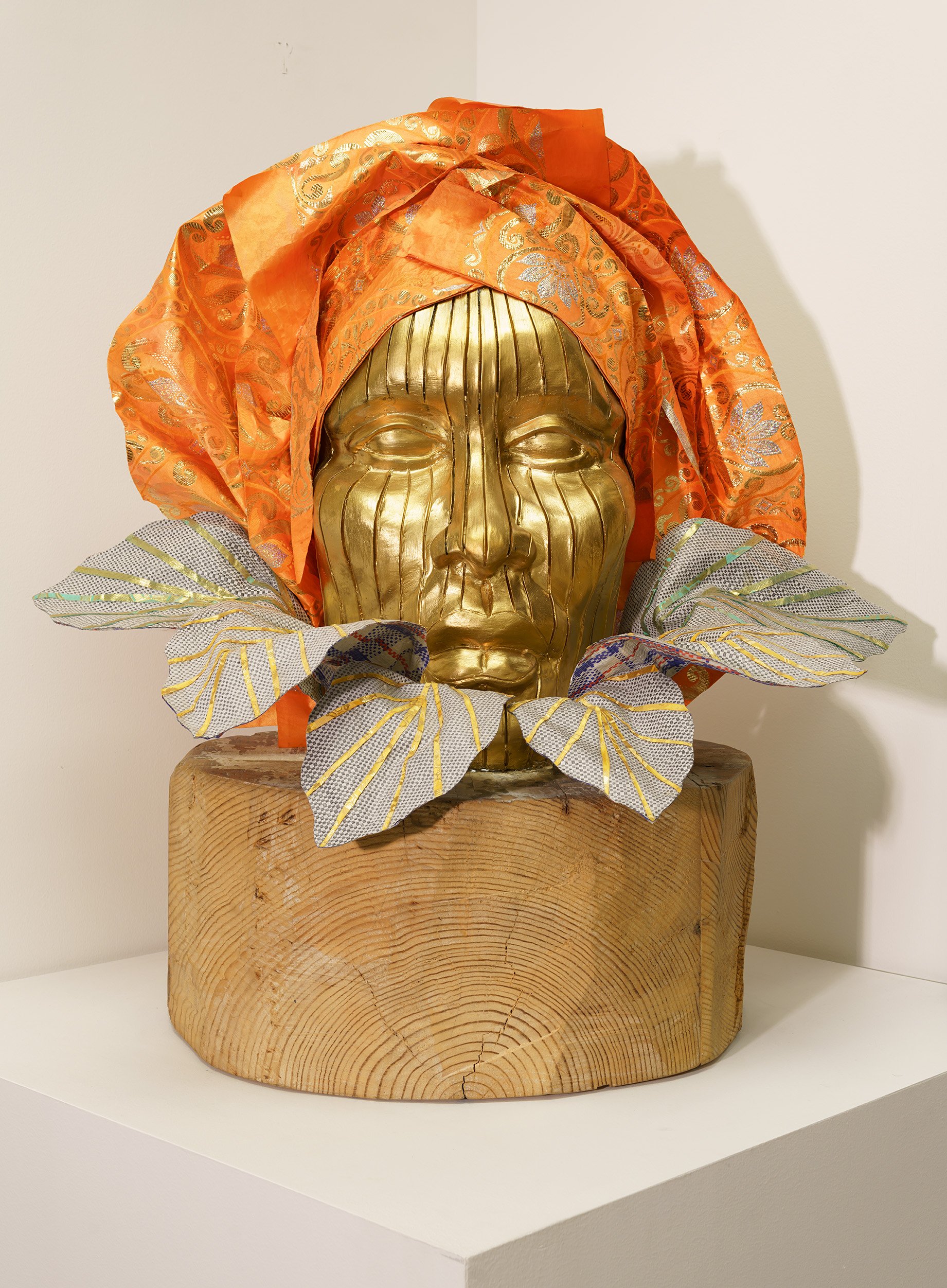
Layo Bright
In the Horseman Collection
A cloth crown and collar of leaves frame a face that is lined with vertical striations. Echoing the golden head it envelops, the gele (pron. GEH-LAY) is lustrous. Its coppery hue is flecked with metallic silver and gold floral patterns that converge with iridescent ribs detailing the leaves below. Seeming to emerge from a segment of tree trunk, the three-dimensional head suggests a botanical sprout, budding to life and full of potential.
Owambe: Bright Orange & Gold, along with related works that showed at Monique Meloche gallery in 2021, blends the ancient and regal with contemporary vernacular expression rooted in the artist’s personal experience and ongoing reflections on memory, identity, and migration. The sculptures’ naturalistic modeling, linear facial markings, and resolute bearing allude to the 12 th to 14 th century Ife heads, aesthetically and technically sophisticated sculptures made of terracotta and lost-wax cast copper alloy depicting an ancient ruling class.1 The Ife sculptures originate from Ile-Ife (pron. EE-LAY EE- FAY), an ancient civilization and site that Yoruba peoples claim as their spiritual seat and origin from which Yoruba culture proliferated across what is today southwestern Nigeria.
Layo Bright traces her family’s origins to Ife; specific ancestors migrated from there to Lagos, where the artist grew up. Bright recalls that most families she knew, including hers, had in their homes a copy of Two Thousand Years of Nigerian Art, a richly illustrated book authored by noted archaeologist Ekpo Eyo.2 Bright was captivated by the Ife heads pictured; “I felt close to those ancient yet present bodies.”3 Nonetheless, the artist noticed a dearth of female representation among the Ife corpus.
Whereas the ancient Ife heads primarily feature forefathers, Owambe celebrates mothers. Commissioned by the Horseman Foundation, Owambe is the largest of the artist’s series of mixed media, gele-wrapped golden heads. In contrast to the others that portray a specific individual or even the artist herself, Owambe portrays -- as the artist explained -- “a composite portrait of inspirational women.” The textiles especially allude to Bright’s own mother and inheritance. The damask gele originates from her mother’s archive of keepsake cloths. Bright relates the ruff of leaves to her earliest works that named specific medicinal botanicals, drawing inspiration from her mother, a pharmacist and the “main healer” in the family in many senses. Bright also cites inspiration from a great-great grandfather who was a babalawo, a traditional Yoruba diviner and healer.
The round, wood foundation is integral to Owambe’s accumulation of plant and lineage derived power. “I view wood and trees as ancestral. Even though this piece of wood’s specific history and land is unknown (beyond its likely origins in the American South), I want to acknowledge the former life of this ancestor – this tree – and nature’s slower pace of making history.” Akin to Bright’s own experiences of homesickness, as a migrant from Nigeria to the United States, she has recognized this piece of wood’s displacement and embraced it as essential to the character of Owambe.
That Bright specifically calls out the textile comprising the leaves as “Ghana-must-go bag,” rather than more mundanely as polypropylene, attests to the artist’s consideration of migration throughout her oeuvre. That epithet for the ubiquitous, capacious plaid shopping bags dates to 1983. A downturn in Nigeria’s economy (precipitated by a global downturn in oil markets) prompted the federal expulsion of some two million Ghanaian and other west African migrants, who hastily fled Nigeria with their belongings stuffed into those bags.4 By creating symbolically potent leaves from this material, Bright offers to remedy its difficult history.
“Owambe” (pron. OH-WAHM-BAY) in the Yoruba language translates as “party” in the English. More specifically, owambe refers to extravagant celebrations, abundant with food and music, where guests wear “traditional dress” like gele, aso ebi (matching or coordinated clothing worn by a group), and aso oke (strip-woven cloth for special occasions). Popular among Lagos urbanites, these (often ticketed) festivities evoke a certain nostalgia for grand family gatherings of the past, perhaps those more closely tied to outlying Yoruba motherlands like Ife and others.
Akin to “the mothers” honored by Gelede masquerades across Yoruba communities in Nigeria and the Republic of Benin,5 Owambe, for the artist, is a portrait of “matriarchal legacy.” Bundled up in festive nostalgia and fortified by a “protective layer” of healing fronds as a salve to uprootedness, Owambe: Bright and Gold offers repair as, "a talisman of hope and care with the power to nurture, heal, and restore.”
Nichole N. Bridges
1 For further reading about Ife, see: Smart History https://smarthistory.org/kingdom-of-ife-sculptures-from-west- africa/example; Kimbell Art Museum, inv. AP 1994.04 https://kimbellart.org/collection/ap-199404; Drewal, Henry John and Enid Schildkrout, Dynasty and Divinity: Ife Art in Ancient Nigeria (New York: Museum for African Art, Fundación Marcelino Botín, and Nigeria National Commission for Museums and Monuments, 2009).
2 Eyo, Ekpo, Two Thousand Years, Nigerian Art (Lagos, Nigeria: Federal Dept. of Antiquities, 1977).
3 Personal communication with the author, August 23, 2024. Unless otherwise cited, subsequent quotes are the artist’s from this conversation.
4 Some references for more context about these bags and their nickname: Cheng, Ying. “‘The Bag Is My Home’: Recycling ‘China Bags’ in Contemporary African Art.” African Arts 51, no. 2 (2018): 18–31, https://www.jstor.org/stable/48547463; and Lawal, Shola, “Ghana Must Go: The Ugly History of Africa’s Most Famous Bag,” Mail & Guardian, https://atavist.mg.co.za/ghana-must-go-the-ugly-history-of-africas-most-famous- bag/ (retrieved August 20, 2024).
5 The “mothers,” also “our mothers” and the “great ancestral mothers,” honored by Gelede masquerades generally comprise female elders, ancestors, and deities. The masquerades celebrate myriad qualities of female power. See Drewal, Henry John and Margaret Thompson Drewal, Gelede: Art and Power among the Yoruba (Bloomington: Indiana University Press, 1990).


























